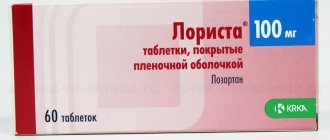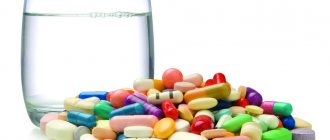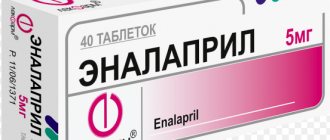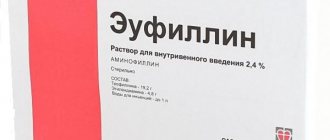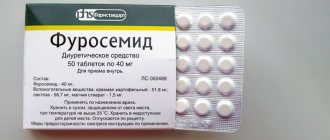Hydrochlorothiazide tablets are used for high blood pressure. The drug has a diuretic effect, as a result of which swelling is stopped, the process of urination is normalized and blood pressure levels are stabilized. The hypertensive effect of the drug is observed only when combined with other medications that normalize pressure in the arteries.
Before use, carefully read the instructions for use, since Hydrochlorothiazide has contraindications, including pregnancy and breastfeeding.
special instructions
- In case of renal failure, monitor the amount of daily urine and blood creatinine.
- For liver diseases, the drug is prescribed with caution, since there is a risk of developing coma.
- When used simultaneously with drugs and alcohol, the decrease in blood pressure increases.
- The drug slows down the speed of reactions, so during treatment it is forbidden to drive a car or engage in mental work.
- In case of low blood pressure and a predisposition to it, the medication is prescribed with caution.
Contraindications
Hydrochlorothiazide tablets, as the instructions for use say, cannot be used for therapy by all patients.
A number of contraindications must be taken into account:
- Anuria;
- Diabetes mellitus with unstable laboratory values;
- Severe liver failure;
- Gout;
- Addison's disease;
- Hyponatremia;
- Hypocalcemia;
- Breastfeeding period;
- Pregnancy (especially in the first trimester);
- Hypersensitivity to sulfonamides.
Tablets are also not prescribed to patients whose medical history is aggravated by lactose deficiency or problems with the absorption of glucose-lactalose. People with cerebral atherosclerosis, eclampsia, and preeclampsia should take medications with extreme caution.
Drug interactions
- In combination with non-steroidal anti-inflammatory drugs, Indomethacin, Clofibrate or indirect anticoagulants, the medication enhances its therapeutic effect.
- When used simultaneously with antidepressants, sedatives or alcohol, symptoms of low blood pressure develop.
- The effect of contraceptives taken orally is reduced during treatment with Hydrochlorothiazide.
- The combination of different diuretics leads to the leaching of potassium and magnesium from the body.
- Hydrochlorothiazide enhances the toxic effect of salicylates on the nervous system, sensitivity to tubocurarine, weakens the effect of drugs that normalize blood glucose levels, norepinephrine.
- The simultaneous use of amiodarone and diuretics leads to interruptions in heart rhythm associated with potassium deficiency.
- The use of vasodilators, beta-blockers, and Diazepam enhances the effect of lowering blood pressure.
- With increasing doses of calcium-containing drugs in combination with Hydrochlorothiazide, excess calcium appears in the body.
Indications
Any medicine must be used according to a medical regimen that is developed by a doctor for each patient. You don't need to prescribe anything yourself.
The drug is prescribed for the following conditions:
- high blood pressure. In this case, Hydrochlorothiazide 25 mg is prescribed. It can be combined with taking additional drugs that belong to the group of thiazide diuretics;
- with swelling, which is caused by massive proteinuria, poor kidney function syndrome, insufficient blood supply, the use of hormones (estrogens, corticosteroids), PMS, malaise in pregnant women;
- with pathology of the renal transport systems (nephrogenic diabetes insipidus);
- eye disease such as subcompensated glaucoma;
- increased amount of calcium in the urine, with normal levels of the element in the blood;
- chronic liver disease with severe ascites.
Patients leave the most positive reviews of Hydrochlorothiazide.
Removing excess fluid from the body is indicated for hypertension and many other diseases
Side effects
- Inflammation of the gallbladder, pancreas, jaundice, lack of appetite, diarrhea, pain in the liver, nausea, vomiting, dry mouth, thirst, constipation.
- Dizziness, headache attacks, nervous excitability, confusion, convulsions, increased fatigue, apathy, burning, tingling, convulsions.
- A sharp drop in pressure when changing body position, rapid heartbeat, irregular heart rhythm.
- Inflammation of the kidneys, decreased potency, renal failure.
- Hives, swelling, skin rash, capillary hemorrhages, inflammation and death of blood vessels.
- Low blood sodium levels, muscle pain, cramps, anemia, decreased white blood cell count.
Pharmacological group
- Thiazide-like or thiazide diuretics
- Medicines that affect kidney function
- Diuretic (diuretic) drugs
Hydrochlorothiazide
is part of combination medicines (analogs):
- cinepress
- adelphanesidrex
- inhibase plus
- adelphanesidrex K
- moduretic
- capozide
- novospirozin
- triampur-compositum
- ategexal compositum
Prices in medical pharmacies of the Russian Federation for different forms and dosages are 85.00 - 136.00 rubles.
Prices in medical pharmacies in Ukraine for different forms and dosages 11.00 - 21.00 UAH.
Reviews about the use of drugs containing hypothiazide are positive.
Overdose
Symptoms:
- rapid heartbeat and irregular heart rhythm;
- constipation;
- decreased daily urine output;
- drowsiness;
- dry mouth.
Exceeding the dose of Hydrochlorothiazide against the background of a sharp decrease in blood pressure can put a person into a coma. If symptoms occur, it is necessary to rinse the stomach and induce vomiting. Next, take intestinal enterosorbents (drugs with absorbing properties), glucose-saline solution, and continue treatment in the hospital.
Composition, mechanism of action and release form
The trade name under which the drug is sold in pharmacy chains is “Hydrochlorothiazide INN.” The pharmacological group of the drug is diuretics. The diuretic contains hydrochlorothiazide as the main active ingredient. Available in tablet form. A standard box contains two blisters of 10 tablets. The principle of action is based on the removal of negative symptoms by removing fluid and breakdown products, salts retained in the body. The drug reduces the rate of reabsorption of chlorine, water and sodium from primary urine into the blood. Thanks to the medication, patients experience relief from swelling, normalization of blood pressure and blood supply, due to the removal of stress from the blood vessels. You do not need a prescription to purchase the medicine, but the dose must be previously agreed upon with your doctor.
Enter your pressure
Move the sliders
120
on
80
Analogs
- Hydrochlorothiazide-SAR . It differs only in the manufacturer and the concentration of the active substance (25 mg). The principle of operation in the body and the chemical composition are identical.
- Hydrochlorothiazide-Verte . The tablets provide a noticeable diuretic effect. Its effect in the body lasts 8-12 hours after use.
- Hypothiazide . There are 20 tablets in a package. Doses of a diuretic drug should not be violated, otherwise sudden cardiovascular failure may develop, leading to coma.
- Dichlorothiazide . Tablets with a diuretic effect that last 6-14 hours.
Methods of application
Hydrochlorothiazide and most of its analogues are intended for oral administration. The starting dosage for hypertensive patients is from 25 to 55 mg per day. On the first day of administration, slight natriuresis or increased diuresis may be observed. This can be considered one of the norm options.
A gradual increase in hydrochlorothiazide leads to a proportional increase in diuresis. It is impossible to exceed the dosage of more than 200 mg per day, since an increase in the effect will not be observed, but the load on the liver and kidneys will increase.
It is recommended to take the medicine once a day in the morning. Elderly patients can take the drug twice a day (12.5 mg).
The maximum daily dose in young patients is determined according to age. The indicators can be viewed in more detail in the table.
| Age | Dosage (µ/kg) |
| Children under 6 months | 3,5 |
| From 6 months to 2 years | 12,5 – 37,5 |
| From 3 to 12 years | 100 mg |
After a five-day intake (in some situations, after three days), a short break in treatment is taken. As maintenance measures, tablets are prescribed twice a week.
To reduce intraocular pressure. The patient is prescribed 25 mg per day. The average course of treatment is up to 6 days. At the same time, it is important to gradually increase the dose to 100 mg per day. As soon as polyuria and thirst decrease, the dosage may be reduced.
Pharmacokinetics[ | ]
Absorbed quickly, but incompletely. TCmax when taken orally at a dose of 100 mg is 1.5-2.5 hours. In the therapeutic dose range, the average AUC value increases in direct proportion to the increase in dose; when administered once a day, the accumulation is insignificant. Bonding with plasma proteins is 40-60%. Penetrates through the hematoplacental barrier and into breast milk. T
½ - 6.4 hours, for moderate chronic renal failure - 11.5 hours, for chronic renal failure with creatinine clearance less than 30 ml/min - 20.7 hours. Not metabolized by the liver. Excreted by the kidneys: mainly unchanged and about 4% in the form of 2-amino-4-chloro-m-benzenedisulfonamide (decreases with alkaline urine) - through glomerular filtration and active tubular secretion in the proximal nephron.
Hydrochlorothiazide tab. 100 mg No. 20
Release form: tablets Composition: Active ingredient: hydrochlorothiazide (in terms of 100% substance) - 25 mg or 100 mg;
Excipients: microcrystalline cellulose, milk sugar (lactose), potato starch, magnesium stearate
Interaction:
With the simultaneous use of antihypertensive drugs and non-depolarizing muscle relaxants, their effect is enhanced.
With the simultaneous use of barbiturates, diazepam, ethanol, the risk of developing orthostatic hypotension increases.
When used simultaneously with GCS, there is a risk of developing hypokalemia, as well as orthostatic hypotension.
When used simultaneously with ACE inhibitors (including captopril, enalapril), the antihypertensive effect is enhanced.
Severe arterial hypotension is possible, especially after taking the first dose of hydrochlorothiazide, apparently due to hypovolemia, which leads to a transient increase in the hypotensive effect of the ACE inhibitor.
The risk of kidney dysfunction increases. The development of hypokalemia cannot be excluded.
With the simultaneous use of oral hypoglycemic drugs, their effectiveness decreases.
With the simultaneous use of calcium and/or vitamin D supplements in high doses, hypercalcemia and the risk of developing metabolic acidosis are possible due to slower excretion of calcium in the urine under the influence of thiazide diuretics.
When used simultaneously with allopurinol, the risk of allergic reactions increases, especially in patients with impaired renal function.
When used simultaneously with digoxin, the risk of developing glycoside intoxication may increase.
When used simultaneously with indomethacin, piroxicam, naproxen, phenylbutazone, the hypotensive effect may be slightly reduced.
When used simultaneously with irbesartan, an additive hypotensive effect may develop.
When used simultaneously with carbamazepine, there are reports of the development of hyponatremia.
When used simultaneously with colestipol and cholestyramine, the absorption and diuretic effect of hydrochlorothiazide decreases.
When used simultaneously with lithium carbonate, the concentration of lithium salts in the blood may increase to a toxic level.
When used simultaneously with orlistat, the effectiveness of hydrochlorothiazide decreases, which can lead to a significant increase in blood pressure and the development of a hypertensive crisis.
When used simultaneously with sotalol, hypokalemia and the development of ventricular arrhythmias are possible.
Dosage form: tablets How to take, course of administration and dosage:
Inside, after eating. The dosage of the drug is determined individually. With constant medical supervision, the minimum effective dose is established.
Adults
As an antihypertensive agent: the usual initial daily dose of the drug is 25-50 mg once, as monotherapy or in combination with other antihypertensive drugs. For some patients, an initial dose of 12.5 mg may be sufficient, either as monotherapy or in combination. It is necessary to use the minimum effective dose, not exceeding 100 mg per day.
If hydrochlorothiazide is combined with other antihypertensive drugs, it may be necessary to reduce the dose of the other drug to prevent an excessive decrease in blood pressure. The hypotensive effect occurs within 3-4 days, but it may take 3-4 weeks to achieve the optimal therapeutic effect. After cessation of treatment, the hypotensive effect persists for one week.
Edema syndrome of various etiologies: the usual initial daily dose is 25-100 mg once a day or once every two days. Depending on the therapeutic effect, the dose can be reduced to 25-50 mg once a day or once every two days. In some severe cases, doses of up to 200 mg per day may be required at the beginning of treatment.
Premenstrual syndrome: The usual dose is 25 mg per day and is used from the onset of symptoms until the onset of menstruation.
Nephrogenic diabetes insipidus: the usual daily dose is 50-150 mg in divided doses.
Children
Doses are set based on the child’s body weight. The usual pediatric daily dose is 1-2 mg/kg body weight or 30-60 mg per square meter of body surface, given once daily. The total daily dose for children under 2 years of age is 12.5 - 37.5 mg; at the age of 2 to 12 years - 37.5 - 100 mg.
Shelf life: 2 years Indications:
Arterial hypertension (monotherapy or in combination with other antihypertensive drugs), edematous syndrome of various origins (chronic heart failure, nephrotic syndrome, premenstrual syndrome, acute glomerulonephritis, chronic renal failure, portal hypertension, treatment with corticosteroids), control of polyuria (mainly in nephrogenic diabetes insipidus ), prevention of stone formation in the genitourinary tract in predisposed patients (reduction of hypercalciuria).
Side effects:
Hypokalemia, hypomagnesemia, hypercalcemia and hypochloremic alkalosis: dry mouth, thirst, irregular heart rhythm, mood or mental changes, cramps and muscle pain, nausea, vomiting, unusual tiredness or weakness. Hypochloremic alkalosis can cause hepatic encephalopathy or hepatic coma.
Hyponatremia: confusion, convulsions, lethargy, slow thinking, fatigue, excitability, muscle cramps.
Metabolic phenomena: hyperglycemia, glucosuria, hyperuricemia with the development of an attack of gout. Treatment with thiazides may reduce glucose tolerance, and latent diabetes mellitus may become manifest. When using high doses, serum lipid levels may increase.
From the gastrointestinal tract: cholecystitis or pancreatitis, cholestatic jaundice, diarrhea, sialadenitis, constipation, anorexia.
From the cardiovascular system and blood (hematopoiesis, hemostasis): arrhythmias, orthostatic hypotension, vasculitis; very rarely - leukopenia, agranulocytosis, thrombocytopenia, hemolytic anemia, aplastic anemia.
From the nervous system and sensory organs: dizziness, blurred vision (temporarily), headache, paresthesia.
Hypersensitivity reactions: urticaria, purpura, necrotizing vasculitis, Stevens-Johnson syndrome, respiratory distress syndrome (including pneumonitis and non-cardiogenic pulmonary edema), photosensitivity, anaphylactic reactions up to shock.
Other: decreased potency, impaired renal function, interstitial nephritis.
Manufacturer: Valenta Pharma, Russia Active ingredient: Hydrochlorothiazide Storage conditions: In a dry place, protected from light, at a temperature not exceeding 25 °C Contraindications:
Hypersensitivity (including to other sulfonamides), anuria, severe renal (Clcreatinine - less than 30 ml/min) or liver failure, difficult-to-control diabetes mellitus, Addison's disease, gout, children's age (up to 3 years).
Quantity per package: 20 Pharmacological action:
Hydrochlorothiazide is a thiazide diuretic. It interferes with the reabsorption of sodium, chlorine and water ions in the distal tubules of the nephron. Increases the excretion of potassium, magnesium, bicarbonate ions; retains calcium ions in the body. The diuretic effect occurs after 2 hours, reaches a maximum after 4 hours and lasts up to 12 hours. Helps reduce high blood pressure. In addition, it reduces polyuria in patients with diabetes insipidus (the mechanism of action has not been fully elucidated). In some cases, it lowers intraocular pressure in glaucoma.
Pharmacokinetics
After oral administration, 60-80% of the dose is absorbed from the gastrointestinal tract. The time to reach Cmax in plasma is 1.5-3 hours. Hydrochlorothiazide accumulates in red blood cells. In the elimination phase, its concentration in erythrocytes is 3-9 times higher than in plasma. Plasma protein binding - 40-70%. Vd in the terminal elimination phase is 3-6 l/kg (equivalent to 210-420 l for a body weight of 70 kg).
Hydrochlorothiazide is metabolized to a very small extent. Its only metabolite found in trace amounts is 2-amino-4-chloro-M-benzene disulfonamide.
The elimination of hydrochlorothiazide from plasma has a two-phase character: T1/2 in the initial phase is 2 hours, in the terminal phase - about 10 hours. In patients with normal renal function, elimination is carried out almost exclusively by the kidneys. In general, 50-75% of an oral dose is excreted unchanged in the urine.
In elderly patients and with impaired renal function, the clearance of hydrochlorothiazide is significantly reduced, which leads to a significant increase in its concentration in the blood plasma. The decrease in clearance observed in elderly patients appears to be associated with worsening renal function. In patients with liver cirrhosis, no changes in the pharmacokinetics of hydrochlorothiazide are observed.
Interaction[ | ]
The simultaneous use of the drug with Li+ salts should be avoided (renal clearance of Li+ decreases and its toxicity increases). Caution should be used with antihypertensive drugs (increased their effect, dose adjustment may be required), cardiac glycosides (hypokalemia and hypomagnesemia during therapy with thiazide diuretics can increase the toxicity of cardiac glycosides), amiodarone (risk of developing arrhythmias associated with hypokalemia), oral hypoglycemic drugs (their effectiveness is reduced, the risk of developing hyperglycemia), corticosteroids, calcitonin (increased hypokalemia), NSAIDs (weaken the diuretic and hypotensive effect), non-depolarizing muscle relaxants (their effect may be enhanced), amantadine (the clearance of amantadine may be reduced, leading to an increase in concentration amantadine in plasma and possible toxicity), cholestyramine (reduces the absorption of hydrochlorothiazide), ethanol, barbiturates and narcotic analgesics, which increase the risk of orthostatic hypotension. Thiazides may reduce plasma concentrations of protein-bound iodine.
